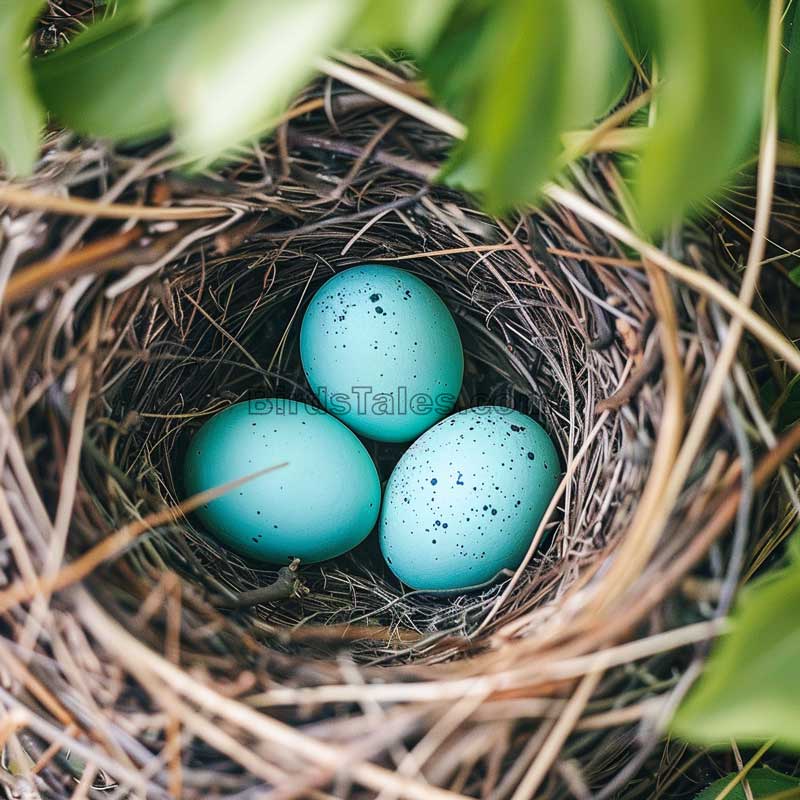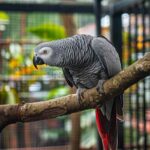Birds That Lay Blue Eggs
Each bird and its eggs are unique.
Observing them enriches our understanding of nature.
Protecting these birds ensures that future generations can enjoy their beauty.
1. American Robin: Light Blue Eggs

The American Robin is a bird you can spot almost everywhere in North America.
What birds lay blue eggs in your backyard?
The American Robin’s light blue eggs are a common sight.
They’re a common sight in backyards.
These birds build their nests in trees, often using mud and grass to make them sturdy.
Robins are early risers, often the first birds to sing at dawn.
This makes them a favorite among bird watchers.
Their light blue eggs are easy to recognize.
Camouflage helps protect these eggs from predators.
The eggs blend in with the surroundings, keeping them safe.
A female robin can lay 3-5 eggs per clutch.
The incubation period lasts about two weeks.
After hatching, the nestlings depend on their parents for food.
Robins are known to be fierce protectors of their nests.
They’ll chase away any threats.
Bird eggs are a point of interest for many bird watchers. The patterns on eggs can help identify the species…
2. Common Blackbird: Bluish-Green, Speckled Eggs
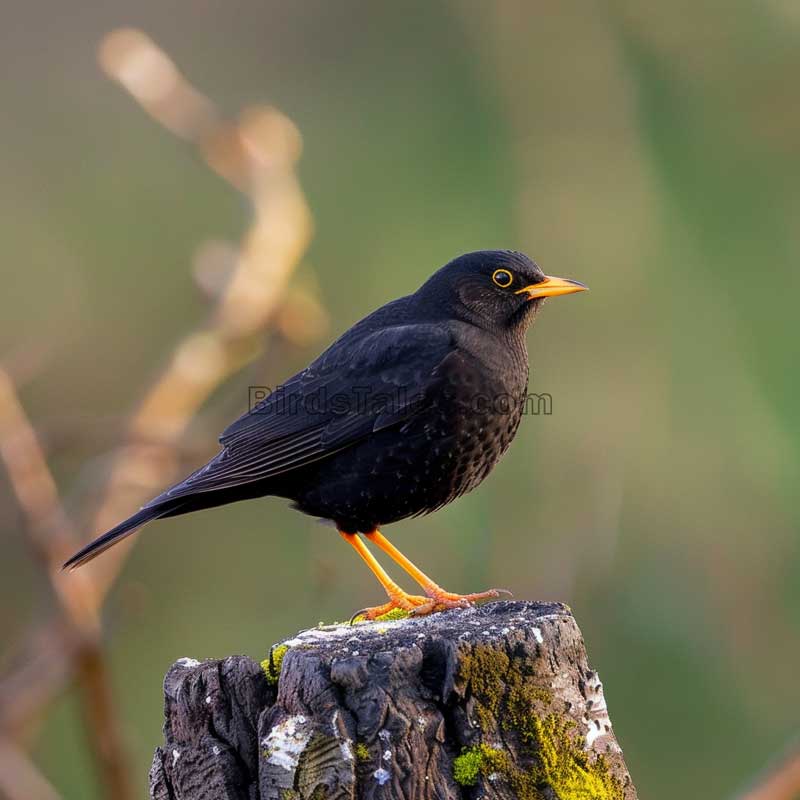
The Common Blackbird is found in Europe, Asia, and North Africa.
These birds are known for their distinctive bluish-green eggs with red specks.
Blackbirds prefer nesting in bushes and trees, often close to the ground.
They use twigs, grass, and leaves to build their nests.
Blackbird eggs are uniquely speckled, giving them a natural camouflage.
This helps them blend into their environment.
A typical clutch contains 3-5 eggs.
The incubation period is around 13-14 days.
Once the eggs hatch, the chicks are fed by both parents.
Blackbirds are very territorial during the breeding season.
They can be seen chasing away intruders from their nests.
3. House Finch: Pale Bluish-Green Eggs

The House Finch is a familiar sight in North America.
These birds are often seen around human habitats.
They nest in buildings, trees, and even hanging planters.
The eggs of the House Finch are pale bluish-green and speckled.
House Finches are known for their adaptability.
They can thrive in urban environments.
A typical clutch contains 2-6 eggs.
The incubation period lasts about 12-14 days.
House Finches are social birds.
They often build their nests close to each other.
This helps them protect their eggs from predators.
Bird eggs are a point of interest for many bird watchers. The patterns on eggs can help identify the species…
4. Song Thrush: Light Blue, Black Speckled Eggs

The Song Thrush is renowned for its singing abilities.
Found in Europe and Asia, this bird lays light blue, black speckled eggs.
For those curious about what birds lay blue eggs, the Song Thrush is a prime example.
Song Thrushes build their nests in trees, using grass and mud.
The speckled eggs of the Song Thrush are well-camouflaged.
They blend in with the nest materials.
A clutch typically contains 3-5 eggs.
The incubation period is about 13-15 days.
Song Thrushes are known for their loud, melodic songs.
They often sing to mark their territory.
These birds are also known for their unique feeding habits.
They use stones to break open snail shells.
5. Mountain Bluebird: Pale Blue Eggs
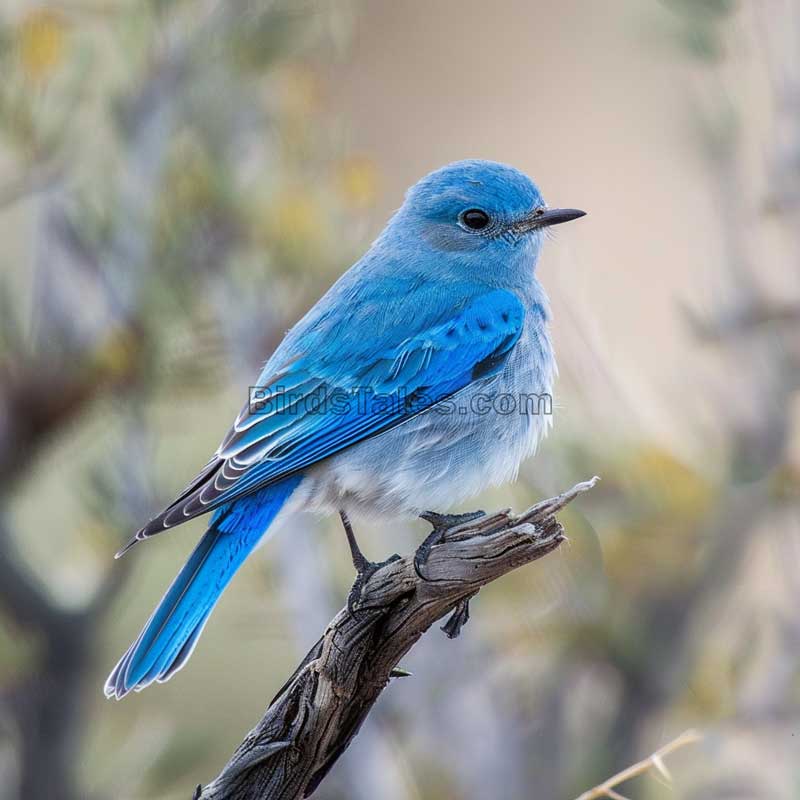
The Mountain Bluebird is a stunning sight in western North America.
These birds lay pale blue to bluish-white eggs.
Mountain Bluebirds prefer nesting in tree cavities or nest boxes.
Mountain Bluebird eggs are distinctive in color.
This blue hue helps in camouflage.
A clutch usually contains 4-8 eggs.
The incubation period lasts around 13-14 days.
These birds are known for their striking blue plumage.
They are also very territorial during the breeding season.
Mountain Bluebirds often engage in aerial displays to defend their nesting sites.
Bird eggs are a point of interest for many bird watchers. The patterns on eggs can help identify the species…
6. Blue Jay: Bluish, Brown Spotted Eggs

The Blue Jay is a common bird in North America.
These birds lay bluish eggs with brown spots.
Blue Jays are known for their intelligence and loud calls.
They build their nests in trees, using twigs, grass, and mud.
Blue Jay eggs are well-camouflaged.
The spots help them blend in with the nest.
A typical clutch contains 3-6 eggs.
The incubation period lasts about 17-18 days.
Blue Jays are very protective of their nests.
They will chase away predators and even larger birds.
These birds are also known for their mimicry.
They can imitate the calls of other birds and even human sounds.
7. Great Blue Heron: Pale Greenish-Blue Eggs

The Great Blue Heron is a majestic bird found near water in North America.
These birds lay pale greenish-blue eggs.
Herons build large nests in trees, often near water.
They use sticks and other plant materials to construct their nests.
Heron eggs are well-camouflaged.
The pale greenish-blue color helps them blend in with the surroundings.
A typical clutch contains 3-6 eggs.
The incubation period lasts about 28 days.
Great Blue Herons are known for their patience.
They can stand still for long periods while hunting for fish.
These birds are also very protective of their nests.
They will aggressively defend their young from predators.
8. American Goldfinch: Pale Bluish-White, Faintly Spotted Eggs

The American Goldfinch is a small bird with vibrant yellow feathers.
It lays pale bluish-white eggs that are faintly spotted.
These birds are widespread across North America and are often seen in fields and gardens.
Goldfinches are known for their acrobatic flight and cheerful songs.
They are late breeders, often waiting until midsummer to lay their eggs.
This timing coincides with the peak abundance of seeds, their primary food source.
The pale bluish-white eggs of the American Goldfinch are usually laid in a well-constructed nest made of plant fibers and spider silk.
A typical clutch contains 4-6 eggs.
The incubation period lasts about 12-14 days.
Goldfinch nests are often hidden among dense vegetation, providing excellent camouflage against predators.
These birds are very social and often form flocks outside of the breeding season.
Watching a group of goldfinches feeding together is a delightful sight.
9. Snowy Egret: Pale Greenish-Blue Eggs

The Snowy Egret is a striking bird with all-white plumage and long black legs.
It lays pale greenish-blue eggs.
These elegant birds are commonly found near wetlands, where they hunt for fish and insects.
Snowy Egrets are known for their graceful hunting technique, often seen wading through shallow water and using their yellow feet to stir up prey.
Snowy Egret eggs are typically laid in a nest built high in trees or shrubs, often in colonies.
A clutch usually contains 3-5 eggs.
The incubation period lasts about 24-25 days.
Both parents take turns incubating the eggs and feeding the chicks once they hatch.
The pale greenish-blue color of the eggs helps to keep them hidden from predators.
Snowy Egrets are a joy to observe, with their delicate movements and striking appearance.
10. Gray Catbird: Turquoise Green, Red Spotted Eggs

The Gray Catbird is a medium-sized songbird known for its distinctive mewing call, which sounds like a cat’s meow.
It lays turquoise green eggs with red spots.
What birds lay blue eggs with such unique markings? The Gray Catbird is a perfect example.
These birds are found in dense shrubs and thickets across North America.
Catbirds are shy but curious, often seen flitting through the underbrush in search of insects and berries.
The turquoise green eggs of the Gray Catbird are laid in a well-concealed nest built from twigs, leaves, and grass.
A typical clutch contains 3-5 eggs.
The incubation period is about 12-15 days.
Catbirds are attentive parents, carefully tending to their eggs and chicks.
The red spots on the eggs help to camouflage them against the nest materials.
Catbirds are known for their mimicry, often incorporating the songs of other birds into their repertoire.
11. Red-winged Blackbird: Blue-Green to Gray, Marked Eggs
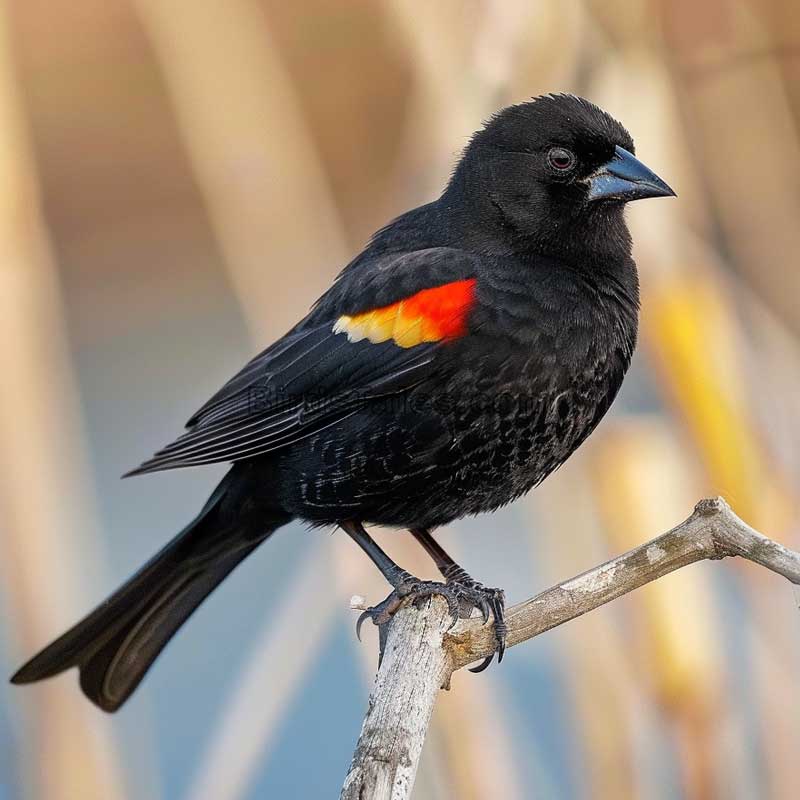
The Red-winged Blackbird is easily recognizable by the red and yellow patches on its wings.
It lays blue-green to gray eggs that are often marked with streaks or spots.
These birds are common in marshes and wet meadows across North America.
Red-winged Blackbirds are highly territorial, especially during the breeding season.
The blue-green to gray eggs of the Red-winged Blackbird are typically laid in a nest woven from plant materials and lined with fine grasses.
A clutch usually contains 3-4 eggs.
The incubation period lasts about 11-12 days.
Female blackbirds are responsible for incubating the eggs and caring for the young, while males vigorously defend the territory.
The markings on the eggs provide camouflage against predators.
Red-winged Blackbirds are known for their loud, musical calls, often heard echoing across wetlands.
12. Wood Thrush: Turquoise-Green, Unmarked Eggs
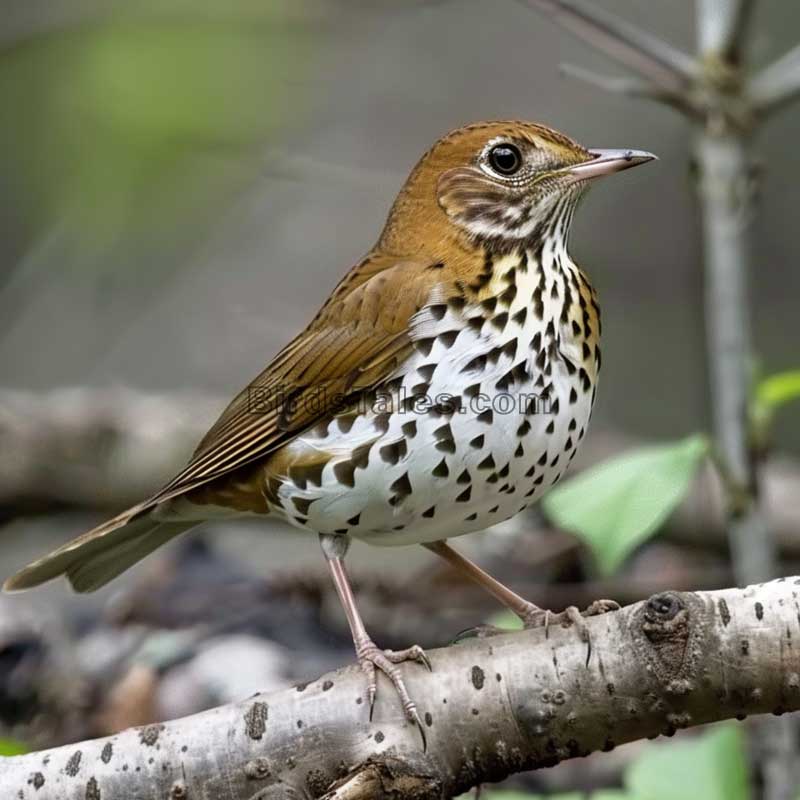
The Wood Thrush is a forest-dwelling bird with a rich, flute-like song.
It lays turquoise-green eggs that are unmarked.
These birds are found in deciduous forests across eastern North America.
Wood Thrushes prefer nesting in the understory, where they build cup-shaped nests from mud and leaves.
The turquoise-green eggs of the Wood Thrush are laid in a well-hidden nest, providing natural camouflage.
A typical clutch contains 3-4 eggs.
The incubation period is about 12-14 days.
Both parents are involved in feeding the chicks once they hatch.
The vibrant color of the eggs is thought to help protect them from predators.
Wood Thrushes are admired for their beautiful songs, which can be heard echoing through the forest in the early morning and late evening.
13. Lesser Goldfinch: Pale Blue-White, Unmarked Eggs
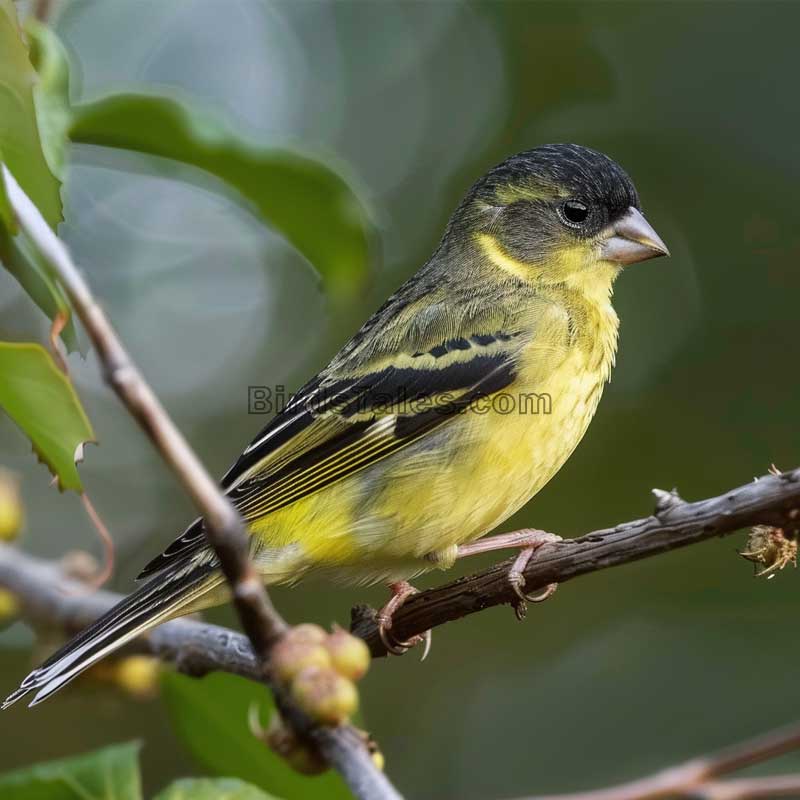
The Lesser Goldfinch is a small, colorful bird found in the southwestern United States and Mexico.
It lays pale blue-white eggs that are unmarked.
These birds are often seen in open woodlands and gardens.
Lesser Goldfinches are known for their cheerful, rapid songs and social behavior.
The pale blue-white eggs of the Lesser Goldfinch are laid in a well-constructed nest made from plant fibers and down.
A typical clutch contains 3-6 eggs.
The incubation period lasts about 12-13 days.
Lesser Goldfinches are attentive parents, and both the male and female participate in feeding the chicks.
The unmarked eggs are well-camouflaged within the nest.
Watching a flock of Lesser Goldfinches flitting about is a delightful experience for bird enthusiasts.
14. Eastern Bluebird: Pale Blue, Unmarked Eggs

The Eastern Bluebird is a charming bird with bright blue plumage.
It lays pale blue, unmarked eggs.
These birds are found in open fields and orchards across eastern North America.
Eastern Bluebirds are cavity nesters, often using old woodpecker holes or nest boxes.
The pale blue eggs of the Eastern Bluebird are laid in a well-protected cavity, providing excellent camouflage.
A typical clutch contains 3-5 eggs.
The incubation period is about 12-14 days.
Eastern Bluebirds are highly territorial and will fiercely defend their nesting sites.
The unmarked eggs are a perfect match for the bluebird’s vibrant blue feathers.
Bluebirds are a favorite among bird watchers, often seen perched on fence posts or singing from tree branches.
15. House Sparrow: Greenish-White to Bluish-White, Spotted Eggs

The House Sparrow is a familiar bird found in urban and rural areas worldwide.
It lays greenish-white to bluish-white eggs that are often spotted.
House Sparrows are highly adaptable and can nest in a variety of locations, from tree cavities to building eaves.
The greenish-white to bluish-white eggs of the House Sparrow are laid in a well-built nest made from twigs, grass, and feathers.
A typical clutch contains 4-5 eggs.
The incubation period lasts about 10-14 days.
House Sparrows are social birds, often nesting in colonies.
The spotted eggs blend well with the nest materials, providing natural camouflage.
Despite their plain appearance, House Sparrows are known for their lively behavior and cheerful chirping.
16. European Starling: Bluish to Greenish-White Eggs
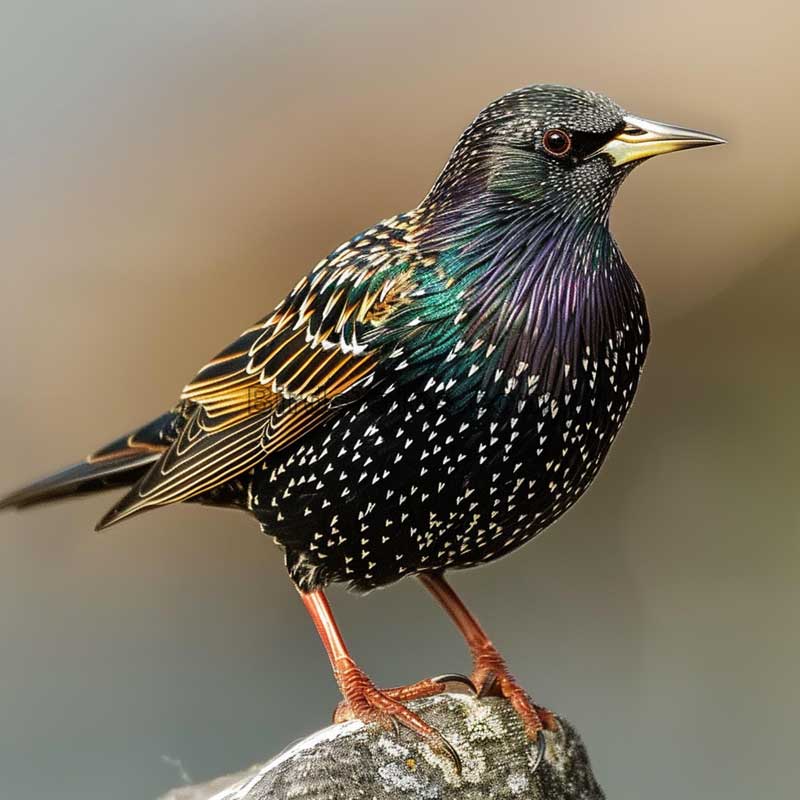
The European Starling is a glossy black bird with iridescent feathers.
It lays bluish to greenish-white eggs.
Starlings are found in many parts of the world, often in large flocks.
These birds are highly adaptable and can nest in a variety of environments, from tree cavities to urban buildings.
The bluish to greenish-white eggs of the European Starling are laid in a sturdy nest built from twigs, grass, and feathers.
A typical clutch contains 4-6 eggs.
The incubation period is about 12-14 days.
European Starlings are known for their complex vocalizations, often mimicking the calls of other birds.
The eggs are well-camouflaged within the nest, helping to protect them from predators.
Watching a flock of starlings perform their synchronized flight patterns is a mesmerizing sight.
Why Do Some Birds Lay Blue Eggs?
The blue color in bird eggs comes from a pigment called biliverdin.
This pigment is present in the oviducts of female birds.
When the egg passes through these ducts, the pigment coats it, giving it a blue color.
So, what birds lay blue eggs and why?
Theories suggest that the blue color helps camouflage the eggs from predators.
The color may also protect against UV rays and help parents identify their eggs.
Conservation Status of Blue-Egg Birds
Many birds that lay blue eggs face threats from habitat loss and environmental changes.
Efforts to conserve these birds focus on protecting their habitats and reducing threats.
Organizations work to ensure these birds can thrive.
Conclusion – What Birds Lay Blue Eggs
Birds that lay blue eggs are fascinating.
Their unique eggs and behaviors add to the wonder of nature.
Preserving their habitats is vital.
Support bird conservation efforts and enjoy bird watching to see these species in their natural environment.
